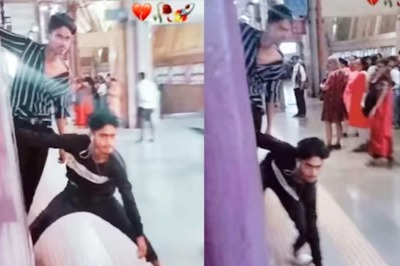
views
Cat Tail Position Meanings
Straight up When a cat’s tail is straight in an upright position, it’s feeling social and confident. The cat is open to interaction, so this is a good time to pet or play with them. This is also a friendly greeting among cats, as it is how kittens greet their mothers. Cats are more willing to approach others if their tail is raised. In some rare cases, a cat may be feeling stressed even if its tail is straight up. Monitor the rest of your cat’s behavior to make sure it’s feeling okay. DeVoss says, “Ears and whiskers forward with an upright tail and tall stance suggest a cat is curious and happy.”
Question mark/hook shape When a cat’s tail is upright but curls at the end (like the shape of a question mark), it is happy and friendly. Like with an upright, straight tail, the cat is open to interaction. Feel free to pet it on its cheeks, under its chin, or next to its ears. Avoid touching its tail, as most cats don’t like this.
Low to the ground When a cat lowers its tail below its back, it is usually frightened or anxious. If the tail is tucked between the cat’s legs, it is extremely scared or may be in pain. If the cat is frightened, it may be best to leave it alone. If you think it is sick or injured, consult a vet. DeVoss says, “Whiskers pressed flat back on the face and a lowered tail or crouched position indicate a cat is unsure of its surroundings.”
Puffed up If a cat’s tail is puffed up and its back is arched (like the Halloween posture), the cat is startled or frightened by a sudden threat. The perceived threat could be another animal, visitors in the home, or a sudden noise. Remove the trigger if possible, and do not try to interact with your cat—it may see you as a threat, as well, and become aggressive. When a cat puffs its tail up, it’s a defensive mechanism made to make the cat seem larger.
Wrapped around the cat’s body If the cat is sitting or lying down with its tail wrapped tightly around its body, it may be feeling sick, frightened, defensive, or in pain. Because your cat does not feel well, avoid interacting with it, and see if there are any potential stressors you can remove from the environment. If your cat frequently crouches with its tail wrapped around itself for several days, consult a vet to make sure it isn’t sick or injured. If the cat’s tail is loosely wrapped around its body, especially when it’s asleep, it may simply be feeling relaxed. Pay attention to your cat’s other behavior and its surroundings to determine if you should be concerned.
Thrashing or thumping If a cat is thrashing its tail rapidly from side to side or thumping it on the ground, it is likely annoyed, irritated, or angry. If your cat starts thumping its tail while you’re interacting with it, it is trying to tell you to stop. It’s best to leave the cat alone or it may exhibit more aggressive behavior, like hissing, scratching, or biting.
Twitching or flicking Cats flick or twitch the end of their tail when they are playing, hunting, or feeling mildly irritated. Observe the environment and the cat’s behavior. If it’s playing with a toy or another animal, it’s probably happy. If it isn’t, the cat may be irritated or frustrated. If the cat is playing or stalking something, allow it to continue engaging. This predatory behavior is important for your cat’s enrichment. DeVoss says, “In the wild, cats hunt six hours a day so it’s important they get the opportunity to ‘hunt’ in your home.”
Swishing When a cat swishes its tail from side to side in a soft, fluid manner, it usually indicates the cat is relaxed or calmly interested in something. The cat is alert but isn’t concerned about anything. In this case, the cat is usually content to spend time by itself.
Quivering Cats sometimes quiver their tail when they’re excited to see a person or another cat. However, if the cat’s tail is straight up and they’re backing up against a surface, they may be urine marking (also known as flagging). Watch your cat carefully if you notice this tail motion to make sure they aren’t urinating outside of the litter box. If the tail quivers are accompanied by skin rippling down the cat’s back, it could be a sign of a disease called hyperesthesia. If this happens frequently, contact a vet.
Wrapped around you or another cat When a cat curls its tail around you, another cat, or another animal, it’s an affectionate greeting. The cat is letting you know it likes you and wants to interact. Think of this behavior as a cat’s version of a handshake or a hug. This is also a way for cats to mark people or things with their scent.
Why Cat Tail Language is Important
Understanding your cat’s body language lets you know how to interact with it. Cats use their tails, ears, eyes, posture, and other body language to let people and other animals know how they’re feeling. Observing your cat’s tail language allows you to understand its emotional state so you know if you should interact with it or give it space. In turn, this teaches the cat to trust you and strengthens your bond. Understanding a cat’s body language also alerts you if they’re sick or hurt so you can get them treatment as soon as possible. DeVoss says, “With cats, you have to take into consideration every body position, sound they are making, and environment surrounding them in order to fully understand what they are trying to say.”
Other Cat Body Language
Happy body language While the tail is often the most obvious way to determine a cat’s mood, pay attention to the rest of its body language, as well. When a cat is happy or content, their posture is typically loose and relaxed. Their eyes may be round or partially closed and their pupils will be narrow slits. Their ears will be upright and forward-facing. Happy cats often purr or trill to show that they’re content and friendly. When a happy cat is lying down, it may expose its belly. This shows that the cat feels safe, but it isn’t necessarily an invitation for a belly rub. Cats may also blink slowly at you to show you they trust and love you. Try slow blinking back! EXPERT TIP Molly DeVoss Molly DeVoss Certified Feline Training and Behavior Specialist & Certified Cat Behavior Consultant Molly DeVoss is a Certified Feline Training and Behavior Specialist (CFTBS), a Certified Cat Behavior Consultant (CCBC), a Fear Free Certified Trainer (FFCT), and the Founder of Cat Behavior Solutions. Molly specializes in using positive reinforcement to modify and prevent unwanted behaviors in cats and reduce cat shelter surrender. Molly has sat on the Dallas Animal Advisory committee since 2013 and was voted one of the Top 12 Extraordinary Cat Behaviorists of 2020 by Catpetclub.com. She is certified by both the Animal Behavior Institute and the International Association of Animal Behavior Consultants. She is also the host of the weekly podcast Cat Talk Radio. Molly DeVoss Molly DeVoss Certified Feline Training and Behavior Specialist & Certified Cat Behavior Consultant Cats communicate from the tip of their nose to the end of their tail. A cat’s body language tells us a lot about what they are feeling. Every part of their body plays a role in expressing their emotions and confidence level.
Playful body language When cats play, they often mimic predatory behaviors. Your cat may crouch down and wiggle its rear end before pouncing on a toy. A playful cat’s eyes will be big with round, dilated pupils, and its ears will be upright and facing forward.
Stressed body language When a cat is stressed, its body will likely be stiff, tense, and low to the ground. Its eyes may appear wide with dilated pupils, and its ears may be rotated to the sides (in an “airplane” pose) or angled backward. A stressed cat may also perform normal behaviors (like scratching or grooming) out of context or urinate or defecate outside of the litter box. Try to determine what the stressor is and remove it. If you suspect you’re stressing your cat out, stop whatever activity or behavior you’re engaging in.
Fearful body language When cats are scared, they often make themselves look smaller by crouching low to the ground and scrunching up their bodies. A frightened cat’s eyes will be wide with dilated pupils, and its ears will be angled backward or sideways. The further pinned back a cat’s ears are, the more frightened the cat is. Scared cats may also hiss or growl in an attempt to scare the threat away. If your cat is scared, remove the perceived threat, but do not attempt to interact with your cat. Frightened cats are prone to aggression, so you or the cat may get hurt.
Aggressive body language To appear intimidating, cats often make themselves look bigger by arching their backs and letting their fur stand up. Aggressive cats’ eyes may be narrowed or wide with enlarged pupils. Their ears will be turned back or flat against their head, and they’ll likely growl or hiss to warn others to back off. Aggressive cats may also spit, lunge, scratch, and bite.
Sick or injured body language When a cat is sick or in pain, it may hunch its body and tuck its legs beneath itself. Its body may appear tense, and its eyes may be squinted or held shut and may appear dazed or glassy. A sick or injured cat’s ears may be held low or to the sides, and an increase in meowing or yowling may indicate emotional or physical distress. While purring is usually a sign a cat is happy, it may also purr because of pain or illness. Sick or injured cats may also hide more frequently, become more aggressive, or experience changes in energy level, appetite, grooming, or sociability. If you suspect your cat is sick or injured, take it to a vet. DeVoss says, “Cats have evolved as a solitary species, so it is thought that they developed meowing to communicate with humans. When they meow, they are commonly trying to get your attention… Cats also meow for medical reasons and to express distress or discomfort.”




















Comments
0 comment